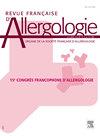CSU disease activity band shift after long-term treatment with remibrutinib in the phase 3 REMIX-1 & REMIX-2 studies
IF 0.3
4区 医学
引用次数: 0
Abstract
Prérequis/contexte
Remibrutinib (REM), a novel oral, highly selective Bruton's tyrosine kinase inhibitor, has previously shown superior efficacy vs placebo (pbo) at week 12 and favourable safety in the 24-week double-blind (DB) period of Phase 3 studies (REMIX-1 and -2) in patients with chronic spontaneous urticaria (CSU) inadequately controlled by H1-antihistamines.
Objectifs
The objective of this analysis was to explore the shift in weekly urticaria Activity Score (UAS7) bands after treatment with REM vs pbo in the REMIX studies.
Méthodes
Patients with CSU were randomized 2: 1 to REM 25 mg twice daily (bid) or pbo over a 24-week DB treatment period, followed by 28 weeks of open-label treatment with REM 25 mg bid (patients on pbo transitioned to REM at week 24). CSU disease activity bands are defined by five standard UAS7 ranges: UAS7: 28–42 (severe), UAS7: 16– < 28 (moderate), UAS7: >6– < 16 (mild), UAS7: >0–6 (well-controlled) and UAS7 = 0 (complete response).
Résultats/discussions
This pooled analysis included 606 patients from the REM and 306 from Pbo arms. At baseline, 215 (35.5%) and 386 (63.7%) patients from REM and 122 (39.9%) and 181 (59.2%) from Pbo had moderate and severe CSU disease activity, respectively. In the REM arm, 63.7% patients were in the severe band at baseline, the number dropped to 24.9, 17.2, 9.1, 7.8, and 8.1% at weeks 1, 2, 12, 24 and 52, respectively. Similarly, of the 35.5% of patients in the moderate band at baseline, the number dropped to 30.7, 24.1, 10.6, 7.9 and 7.3% at weeks 1, 2, 12, 24 and 52, respectively. There were no patients in the well-controlled disease band at baseline; however, the numbers increased from 11.4 and 15.3% at weeks 1 and 2 to 17.8% at week 12, followed by 14.9% at week 24 and 13.4% at week 52. Notably, proportion of patients who showed complete response increased from 0.3% at week 1 to 16.2% at week 2, followed by 28.5% at week 12, 33.7% at week 24 and 35.1% at week 52. At the end of week 52, patients who switched to REM after the Pbo reached similar band shifts.
Conclusion
REM reduced CSU disease activity as early as week 1 in patients with CSU, and the fast response was sustained over the long-term (52 weeks) treatment.
在REMIX-1和REMIX-2期研究中,长期使用remibrutinib治疗后CSU疾病活动性频带改变
emibrutinib (REM)是一种新型的口服高选择性布鲁顿酪氨酸激酶抑制剂,在第12周的3期研究(REMIX-1和-2)中显示出优于安慰剂(pbo)的疗效,并且在24周的双盲(DB)期中显示出良好的安全性,用于慢性自发性荨麻疹(CSU)患者,慢性自发性荨麻疹(CSU)不受h -抗组胺药的充分控制。目的本分析的目的是探讨REMIX研究中REM与pbo治疗后每周荨麻疹活动评分(UAS7)频带的变化。CSU患者在24周的DB治疗期间随机分为2组:1组接受REM 25 mg每日2次(bid)或pbo治疗,随后接受28周开放标签治疗,REM 25 mg bid (pbo治疗的患者在第24周过渡到REM)。CSU疾病活动带由5个标准UAS7范围定义:UAS7: 28-42(严重),UAS7: 16 - <;28(中等),UAS7: >6 - <;16(轻度),UAS7: 0 - 6(控制良好),UAS7 = 0(完全缓解)。该汇总分析包括606例REM组患者和306例Pbo组患者。基线时,REM患者215例(35.5%)和386例(63.7%),Pbo患者122例(39.9%)和181例(59.2%)分别有中度和重度CSU疾病活动。在REM组,63.7%的患者在基线时处于严重频带,在第1、2、12、24和52周时分别下降到24.9%、17.2%、9.1、7.8和8.1%。同样,在基线时35.5%的中度组患者中,在第1、2、12、24和52周分别降至30.7%、24.1、10.6、7.9和7.3%。基线时无患者处于控制良好的疾病带;然而,这一数字从第1周和第2周的11.4%和15.3%上升到第12周的17.8%,随后是第24周的14.9%和第52周的13.4%。值得注意的是,完全缓解的患者比例从第1周的0.3%增加到第2周的16.2%,其次是第12周的28.5%,第24周的33.7%和第52周的35.1%。在第52周结束时,Pbo后转入REM的患者也达到了类似的频带移位。结论rem早在第1周就降低了CSU患者的疾病活动性,并且在长期治疗(52周)中持续快速反应。
本文章由计算机程序翻译,如有差异,请以英文原文为准。
求助全文
约1分钟内获得全文
求助全文
来源期刊

Revue Francaise d Allergologie
Medicine-Immunology and Allergy
自引率
33.30%
发文量
349
期刊介绍:
La Revue Française d''Allergologie : un véritable forum pour faire connaître des travaux originaux et permettre la diffusion de l''information auprès de toutes les spécialités concernées par les pathologies allergiques. La Revue Française d''Allergologie (8 numéros par an) est au carrefour de nombreuses spécialités - dermatologie, pédiatrie, ORL, pneumologie, ophtalmologie, médecine interne - qui, toutes, ont à traiter des maladies allergiques. Les symptômes des allergies fondés sur des mécanismes communs sont le plus souvent associés et se succèdent chez un même patient. En forte progression depuis 20 ans, les maladies allergiques sont dans l''attente de perfectionnements et d''avancées thérapeutiques qui permettront aux nombreux patients qui en sont atteints de mieux vivre avec leurs allergies. La Revue Française d''Allergologie se veut donc un véritable forum de discussions et d''échanges entre tous les spécialistes confrontés aux pathologies
 求助内容:
求助内容: 应助结果提醒方式:
应助结果提醒方式:


